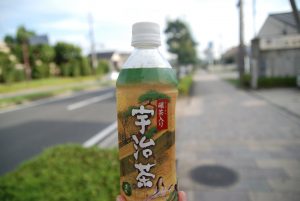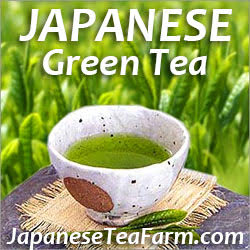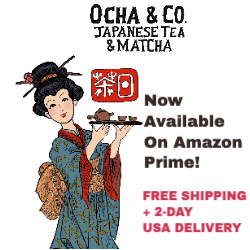 It can hardly be argued that Japanese Green Tea is becoming popular and is gaining more recognition outside of Japan.
It can hardly be argued that Japanese Green Tea is becoming popular and is gaining more recognition outside of Japan.
Because of the recent discoveries regarding the health benefits of matcha, this variation of Japanese tea in particular is having an impressive market growth in Western countries.
However, in Japan the reality is close to the opposite. Partially because of the invention of bottled tea, the traditional loose leaf tea is being shoved to the background, whilst matcha is close to being perceived as an exclusive and luxury product solely used in the tea ceremony.
The ease of only having to pick up a bottle, as compared to having to brew the tea by yourself, has already had a great impact at the base of this issue. In this guest post, I wish to briefly portray my perception and opinion on the current status and problematic of the green tea industry in Japan.
I would like to indicate that though influenced by data and perceptions from reliable resources, the opinions as presented below are solely my own. The subject is open for discussion and I will be happy to receive any comments or criticism if your vision or understanding might differ.
Recent history of the green tea market in Japan
In the late 90’s Japanese green tea sales gradually entered a period of stagnation. In order to support the regular green tea farmer, it was necessary to blow a new breeze in the industry.
It was around this time that the invention of tea in pet bottles took place. By 1999, bottled tea increased its share on the Japanese green tea market and by 2005; this innovative approach already gained most of its current popularity.
In order to support this new “market”, an approximate amount of 26,000 tons of tea leaves were required, which resulted in a completely new demand for tea.
This new approach to Japanese tea was a success in terms of supporting the tea farmer and in creating a new demand for larger amounts of tea. However, the ease of just having to pick up a bottle gradually led to a deviation from regular and higher-grade leaf tea consumption.
High quality tea variations such as gyokuro or high grade sencha dropped in demand, while the production of lower grade sencha and similar lower grade tea leaves experienced a tremendous growth.
Of course, it goes without mention that other factors such as the availability of other western drinks such as coffee, black tea and soft drinks also played a part in this change. The market became more competitive and tea had to adapt to this.
Something that illustrates this change rather well is the gradual disappearance of the Japanese tea pot, or kyūsu, from contemporary, mostly younger, Japanese households. A kyūsu used to be available in every household several decades back, but households have replaced this item by coffee machines nowadays.
As society has become more rapid and tense we have lost our patience, the ability to wait. The Japanese teapot and tea leaves have been replaced by easy to use tea bags and drink-ready pet bottles. In succession, the understanding and knowledge of how to brew a delicious tea has gradually started to fade and this leaves other higher-grade tea variations suffering.
The tea industry, however, understands and recognizes the graveness of this drawback and has already taken counter measures to overcome this new issue. I would like to introduce three of the main solutions which are currently being applied in order to re-educate the population on their culturally valuable product, tea.
The Japanese Tea Instructor Association
Founded in 2002 as an NPO, the Japanese Tea Instructor Association (日本茶インストラクター協会) educates instructors, who on their turn can, with the knowledge and data provided by the association, re-educate the people regarding tea variations, brewing methods, other applications of tea, etc.
Currently, the organization also educates tea advisors and conducts a private and voluntary examination to test your basic understanding and knowledge of tea with the intention to educate the regular person with a basic understanding that can be applied in their everyday tea experience.
Japanese green tea cafes
Another approach is the rise of Japanese green tea cafes, restaurants and bars. Where in the past green tea was close to solely available for free as refreshment upon entering a restaurant, now different tea variations can be enjoyed at these specialized places.
Usually a few varieties such as sencha, gyokuro and matcha can be enjoyed, often thanks to a Japanese tea instructor or advisor. In further attempts to re-educate the customer, at most places, separate events, workshops or specified classes are organized. It is thus not surprising that many tea stores put this opportunity to use and now also have their separate cafe compartment where customers are received.
As mentioned earlier, green tea is usually served as a welcome drink upon entry of a store or restaurant and sometimes even after lunch or diner. These tea refreshments are usually free of charge and are perceived as a mandatory custom in Japanese etiquette.
Since these teas are usually bancha, hōjicha or other lower grade varieties, this particular perception makes it difficult for Japanese green tea cafes to convince the customer to pay for a cup of higher grade sencha or gyokuro and that their quality is worth the price.
On the other hand, the Japanese customer doesn’t hesitate when purchasing a western beverage such as a coffee or black tea. In order to re-instigate and grow the recognition of Japanese green tea, the industry will have to overcome this hurdle in order to eventually compete on a fair level.
Green tea sweets
Matcha has been used in food and rice cakes for centuries. The understanding that tea can also be eaten has forever been present in Japan.
Only recently has this aspect of tea consumption taken a new turn and is being applied to western sweets as well. Various “matcha-flavored” sweets such as cakes, macarons, candies, etc. are being produced and have become extremely popular, especially among the younger generations.
Not only is the sweets sector a new support to keep the green tea demand going, is it also the perfect signboard for Japanese green tea cafes. Because of it’s popularity, sweets can be employed to catch the attention of new customers and create an opportunity to spread information on higher grade teas as well.
Japanese green tea has always been in constant flux. The Japanese teas that we know today are most certainly not the teas that were known a few hundred years back. A few examples of how the perception of tea changed are: when the manufacturing method for sencha was invented in 1738 by Nagatani Sōen; or when the demand for matcha declined in the early 19th century and gyokuro was invented as a new way of processing tencha leaves; or when in the early 1920’s hōjicha was discovered as a method to process merchant’s stocks when sales stagnated to recuperate older leaves.
All these periodical and societal influences brought about a shift in the approach and usage of tea. The same can be said of the invention of the pet bottle and the processing of green tea into sweets.
Society has deviated from an older way and now calls for a new and fresh approach. As the industry most greatly affected is the farming industry, the changes reflect here as well. For example, when the demand for pet bottle tea rose, tea farmers adjusted to produce more tea leaves suited for pet bottle use. And with the upcoming of tea sweets and also the rising demand for matcha abroad, tea farmers gradually started to shift their production to tencha leaves to meet with this new demand.
As I mentioned at the beginning, there is a rising demand for matcha outside of Japan. The main reason for this is mostly because of recent research leading to the discovery of various health benefits, and as the West has grown more health conscious in the last few years, this aspect manages to draw a lot of attention.
As Japanese Green Tea is struggling with domestic demand and with the re-education of the consumer’s understanding and interest of higher quality, green tea in general and matcha in specific are being received with arms wide open on an international scale. Japanese green tea farmers are shifting their production to tencha as the base for matcha products and many Japanese tea stores are taking the leap outside of Japan.
In succession to new inventions and the discovery of new approaches to Japan’s tea, perhaps the time has come to leave its trusted environment and expand its borders?
To me the answer is clear. Re-educating the Japanese consumer is one thing, but bringing the enjoyment, powers and benefits of Japanese green tea to an international consumer base is a much greater challenge and I aim to make my contribution to the cause.
How do you think the Japanese tea industry is about to evolve and what shifts do you foresee for the future? Let’s continue the conversation in the comment section below.
About the author:
Tyas Huybrechts, born and raised in Antwerp, Belgium. Currently resides in Osaka, Japan.
He is the author of Tea Talk, soon to be certified Japanese Tea Instructor and Tea Master in the Enshu-ryu tea ceremony tradition.






January 27, 2015
Thanks to Tyas for the great article!
From my observations, there are more and more tea shops on Rakuten that open their doors to international customers. When I was looking for tea on Rakuten 4 years ago, I needed a shopping service to get my hands on their teas. Now there are still many tea shops that do not offer international shipping but some of them already know where the future priorities of Japanese tea will lie. Of course you are asked to submit a request in Japanese as far as possible, but shopping also works great with google translate. 😉
I do not have any precise idea about how the tea industry is going to develop especially in Europe. But I am curious about what will happen when the Matcha trend ends.
January 27, 2015
Oca Ocani,
Thank you for your comment.
I am actually pleasantly surprised and happy that you bring up your curiosity about where the matcha “trend” will end up in a couple of years.
There are indeed quite some concerns about this new “fever” and the over-promising ways of marketing matcha which are applied currently. It also isn’t clear if it will be a quickly fading hype or not.
This is what witholds many Japanese tea vendors to join the craze and leap into the international market. It may seem safer to wait untill everything has stabilized. On the other hand, it can’t be neglected that the tea stores that have already taken the step greatly profit from it.
In my perception, the hype will slowly start cooling down, but by the time it does, matcha will have gained a solid position on the international market and a new position within western households, that it’s popularity will hold at a stabilized level in the future as well.
January 30, 2015
Great article. I live in HK and the “greentea” related business is booming, all because of the greentea / matcha-related sweets starting from Matcha soft serves. People here start to experience what real matcha tea is about via trying in temples in Japan or even making their own. The progress for drinking part is slow but dessert is exploding. To me as a greentea lover it’s all good thing because that means more merchants are willing to bring tea products to here.
Again love your post! Keep up the good work!
February 1, 2015
Hello Michael,
Thank you very much for your very insightful comment. The first place Japanese Green Tea is exported to are off course the nearer Asian countries. Even though the amount of Japanese tea that is exported is largest in the direction of the USA, the popularity of Matcha, Matcha drinks and Matcha based sweets is booming tremendously in countries such as China, Hong Kong, Taiwan, Singapore, Malaysia, etc.
I find it interesting how different the approach towards Japanese tea can be between Asia and the West, even though it is the same product. I feel that in the west, the attention goes more to drinking tea and consuming Matcha the original way in order to benefit from it’s health benefits, while on the other hand, I get the feeling that in Asia Matcha it is more perceived as a delicious ingredient for sweets such as cakes, ice, etc. and a base for Matcha drink variations such as Matcha Latte or Matcha smoothies.
It’s a growing market with a lot of possibilities and I am eager to see how it will evolve towards the future.
I am certain more Japanese large tea brands are soon to have a presence in Hong Kong as well.
February 2, 2015
Thanks for your reply.
I’m sure the Japanese greentea market as tea product is huge to Western market. For Asian markets, I see the reception is fairly different because all Asian countries have long history of drinking tea / planting tea leaves. For some they feel proud of their own tea that they have little interest to try out tea from Japan, especially Japanese tea generally is more delicate than Chinese ones (in terms of temperature). If you tell my parents that oh these tea leaves need to be prepared at 70-80C, they would give me a weird look coz they’ve been drinking tea w/ hot water for so long. So lately genimaicha has been gaining popularity as people can brew them the same way as Chinese tea, plus they sound healthy.
February 3, 2015
It is true that Japanese teas are more “labor-intensive” to brew. Some people find it troublesome, others believe it’s the charm of the tea. I can imagine that it would be more difficult to accept this in countries or regions with a green tea tradition of their own. This may also clarify why sweets and the less common Matcha variation of green tea know larger popularity in those regions at first hand.
February 11, 2015
Tyas, this is a very interesting subject – something that I’ve also considered over the years (though without as much knowledge of the industry in Japan).
In the UK Japanese tea is fairly unknown, but any mention of “Green Tea” and the first thing I hear is “Weight Loss”…
This isn’t anything new and every so often we hear of new ‘superfoods’ that are hyped up and plastered through the media for months on end, before the trend calms down.
Just look at Google Trends for Matcha in the UK, it’s at an all time high: http://www.google.co.uk/trends/explore#q=matcha&geo=GB&cmpt=q&tz=
I too wonder where the trend will end, if we’re only at the beginning, or if people are soon to get bored and move to the next item.
If you haven’t already, you should definitely connect with Ian at Yunomi.us, they’re doing wonderful things for farmers in Japan and helping to grow the international market, something that we’re planning on doing as soon as we’re able.
We have our own plans to help increase international interest and it’s great to see so many who share the same ideals.
Just a quick question, how likely do you think we are to see a significant turn-around in Japan?
I mean, with the ease of picking up a bottle and with tea unlikely to see the hype we have here in the UK, can the Kyusu become a must-have item in every household again?
February 11, 2015
Hi James,
Thank you for your kind remarks.
“Weight loss” is indeed a very large factor used in marketing green tea. However, eccept from the fact that green tea contains a lot of anti-oxidants and improves our digestion, I am rather sceptical to say that it actually has any fat-/calorie burning effects and that it can be categorized as an actual “diet.” I am not meaning this as an offense to anyone, but if we replace the amount of pop, soda or coke we consume on a daily basis in our contemporary western society with anything that contains less sugar, I am sure that that will result in amazing weight loss results.
What I believe should be focussed on more when it relates to health benefits is the way it counteracts to the development of cancer cells (also note that tea is not a cure as many try to make believe. It may just have a preventing effect.) Or the lesser known benefits of working against bad breath.
I am also very grateful for your question. Though I am not sure to what extent I am actually able to form a satisfiable answer.
As I mentioned in my article, a lot of instances as the Instructor association and various tea stores as well are putting an effort to re-educate people on how to brew a delicious tea with a kyusu and are trying to get more people to drink tea this way.
Other instances are re-purposing tea leaves already by using them in sweets and the farming industry is also adjusting in this direction.
I believe that tea will maintain it’s cultural important position with all it’s various high class tea variations and brewing methods, but it is hard to say to what extent we may actually see a re-vitalisation of the kyusu in contemporary households.
February 12, 2015
Hi again Tyas,
I fully support your stance on fizzy drinks – this is where part of the hype lies, as a switch results in fewer calories and thus weight loss, the amazing results are often attributed to the replacement (“Green Tea”) vs the fewer calories consumed. Some are quick to quote studies that ultimately show such subtle effects that they are barely existent, as proof of it working.
I’m fascinated by all of the work around Angiogenesis and Cancer research and agree that should be where the focus lies, if any.
At the very least, the media acts as a catalyst to get new audiences interested in the subject, where they can then perform their own research, as this is how I started.
I’m finding that younger people I introduce to speciality teas are more receptive and willing to try it, especially when it comes to making it correctly with temperature controlled water and a teapot.
Thinking about it, it’s an odd truth that as interest in Japanese within Japan falls and becomes more niche, it’s rising internationally.
I think it all comes down to what we’re used to, so the west is used to fizzy drinks, black tea and coffee, while Japan is used to green tea, ultimately it’s along the lines of the “I want what he’s got” situation.
I think this is something to revisit in five years time, as everyone’s combined efforts should surely scale in that time – there’s a post to add to your calendar 😉
Thanks for getting back to me, when I’m able I’ll be sure to drop by your blog on a regular basis! Take care
February 15, 2015
Hi James,
That’s exactly the point I was trying to make. To fully enjoy the true character of Japanese green tea, it might even be better to forget about those possible benefits. And if they might exist and if you are so lucky to enjoy any health related benefits from drinking green tea, I’d take it as a happy extra. In first instance, I believe Green Tea should be drunk for it’s enjoyment and pleasure.
In Japan, it is an odd course of action indeed and I quite like your analogy. “I want what he’s got.” Very suitable!
I’d be happy to do a review in a couple of years and have a look at where we’ve gotten with the “hype” abroad as well as with the fall in interest and efforts to re-instigate awareness within Japan.
I hope you’ll be there again too to discuss and look back on certain evolutions. It truly is an intriguing topic.